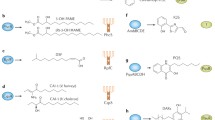Abstract
A thiolactone/lactone peptide-mediated quorum sensing (QS) system is commonly employed in gram-positive bacteria to control the expression of a variety of phenotypes, including the production of virulence factors and biofilm formation. Here, we describe assay protocols for the well-studied QS systems (agr and fsr) of two representative gram-positive pathogens, Staphylococcus aureus and Enterococcus faecalis. These convenient assay systems are useful for the screening of QS inhibitors as well as for basic research to address the mechanism of these QS systems.
Access this chapter
Tax calculation will be finalised at checkout
Purchases are for personal use only
Similar content being viewed by others
References
Miller MB, Bassler BL (2001) Quorum sensing in bacteria. Annu Rev Microbiol 55:165–199
Horinouchi S, Ueda K, Nakayama J, Ikeda T (2010) Cell-to-cell communications among microorganisms. In: Lew Mander L, Liu H-W (eds) Comprehensive natural products II, vol 4. Elsevier Science, Amsterdam, pp 283–337
Recsei P, Kreiswirth B, O’Reilly M et al (1985) Regulation of exoprotein gene expression by agr. Mol Gen Genet 202:58–61
Qin X, Singh KV, Weinstock GM, Murray BE (2000) Effects of Enterococcus faecalis fsr genes on production of gelatinase and a serine protease and virulence. Infect Immun 68:2579–2586
Wuster A, Babu MM (2008) Conservation and evolutionary dynamics of the agr cell-to-cell communication system across firmicutes. J Bacteriol 190:743–746
Novick RP (2003) Autoinduction and signal transduction in the regulation of staphylococcal virulence. Mol Microbiol 48:1429–1449
Qin X, Singh KV, Weinstock GM, Murray BE (2001) Characterization of fsr, a regulator controlling expression of gelatinase and serine protease in Enterococcus faecalis OG1RF. J Bacteriol 183:3372–3382
Nakayama J, Chen S, Oyama N et al (2006) Revised model for Enterococcus faecalis fsr quorum-sensing system: the small open reading frame fsrD encodes the gelatinase biosynthesis-activating pheromone propeptide corresponding to staphylococcal agrD. J Bacteriol 188:8321–8326
Nakayama J, Cao Y, Horii T et al (2001) Gelatinase biosynthesis-activating pheromone: a peptide lactone that mediates a quorum sensing in Enterococcus faecalis. Mol Microbiol 41:145–154
DeLeo FR, Otto M, Kreiswirth BN, Chambers HF (2010) Community-associated meticillin-resistant Staphylococcus aureus. Lancet 375:1557–1568
Murray BE (2000) Vancomycin-resistant enterococcal infections. N Engl J Med 342:710–721
Nakayama J, Uemura Y, Nishiguchi K et al (2009) Ambuic acid inhibits the biosynthesis of cyclic peptide quormones in gram-positive bacteria. Antimicrob Agents Chemother 53:580–586
Nakayama J, Tanaka E, Kariyama R et al (2007) Siamycin attenuates fsr quorum sensing mediated by a gelatinase biosynthesis-activating pheromone in Enterococcus faecalis. J Bacteriol 189:1358–1365
Lyon GJ, Mayville P, Muir TW, Novick RP (2000) Rational design of a global inhibitor of the virulence response in Staphylococcus aureus, based in part on localization of the site of inhibition to the receptor-histidine kinase, AgrC. Proc Natl Acad Sci U S A 97:13330–13335
Nakayama J, Yokohata R, Sato M et al (2013) Development of a peptide antagonist against fsr quorum sensing of Enterococcus faecalis. ACS Chem Biol 8:804–811
Chan WC, Coyle BJ, Williams P (2004) Virulence regulation and quorum sensing in staphylococcal infections: competitive AgrC antagonists as quorum sensing inhibitors. J Med Chem 47:4633–4641
Zhao ZG, Yan SS, Yu YM et al (2013) An aqueous extract of Yunnan Baiyao inhibits the quorum-sensing-related virulence of Pseudomonas aeruginosa. J Microbiol 51:207–212
Desouky SE, Nishiguchi K, Zendo T et al (2013) High-throughput screening of inhibitors targeting agr/fsr quorum sensing in Staphylococcus aureus and Enterococcus faecalis. Biosci Biotechnol Biochem 77:923–927
Qazi SN, Counil E, Morrissey J et al (2001) agr expression precedes escape of internalized Staphylococcus aureus from the host endosome. Infect Immun 69:7074–7082
Mäkinen PL, Clewell DB, An F, Mäkinen KK (1989) Purification and substrate specificity of a strongly hydrophobic extracellular metalloendopeptidase (“gelatinase”) from Streptococcus faecalis (strain 0G1-10). J Biol Chem 264:3325–3334
Acknowledgments
We would like to thank Prof. Paul Williams for providing the reporter strain S. aureus 8325-4(p2035). This research was supported in part by grants in aid for Scientific Research (B) Nos. 2138006 and 24380050 from the Japan Society for the Promotion of Science and from the Adaptable and Seamless Technology Transfer Program through Target-Driven R&D (A-step) (AS232Z02064G) from the Japan Science and Technology Agency.
Author information
Authors and Affiliations
Corresponding author
Editor information
Editors and Affiliations
Rights and permissions
Copyright information
© 2014 Springer Science+Business Media New York
About this protocol
Cite this protocol
Shojima, A., Nakayama, J. (2014). Quorum Sensing in Gram-Positive Bacteria: Assay Protocols for Staphylococcal agr and Enterococcal fsr Systems. In: Donelli, G. (eds) Microbial Biofilms. Methods in Molecular Biology, vol 1147. Humana Press, New York, NY. https://doi.org/10.1007/978-1-4939-0467-9_3
Download citation
DOI: https://doi.org/10.1007/978-1-4939-0467-9_3
Published:
Publisher Name: Humana Press, New York, NY
Print ISBN: 978-1-4939-0466-2
Online ISBN: 978-1-4939-0467-9
eBook Packages: Springer Protocols




